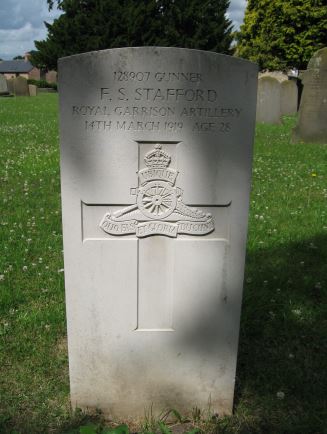9th Company, Royal Garrison Artillery

There are a couple of unusual features of Frederick Stafford’s story, one is that he has a surviving Army Service Record and an Army Pension Record, the other is that these records state he only served ‘at Home’, when in fact he served abroad, in Gibraltar (which was probably considered as ‘at Home’, similar, in those days, to Ireland).
Frederick Stanley Stafford was born at Leonard Stanley in 1890 and baptised there on 15 June of that year. His parents were Alfred Stafford (1851-1929) and his wife Helena ‘Ellen’ (née Rogers: 1853-1930). Alfred Stafford appears to have undertaken a range of occupations: according to the 1891 Census he was a shoemaker, in 1901 a bootmaker and in 1911 he was a carriage driver. The constant theme is that the family lived at The Marsh, Leonard Stanley, throughout this period. The couple had six children, all living at the time of the 1911 Census; a daughter had died in 1908.
The 1911 Census has Frederick (age 20) as ‘assisting at home’ but when his time came for him to join the Army, he stated his occupation to be a haulier.
Frederick was conscripted into the Army, under the provisions of the Military Service Act, 1916, on 9 November 1916. His Service Record is part of the ‘burnt documents’, salvaged from the incendiary bombing raid on the repository holding the Army records in 1940. His Pension Record contains much more detail.
On conscription, Frederick’s fitness category was assessed as B1, which indicated that he was fit for most duties, except front line service. He expressed a wish to serve with the Remounts (or Army equine stock) but was placed with the Royal Garrison Artillery. His initial posting was to No 3 Depot at Plymouth, after which he was despatched to Gibraltar on 30 November 1916, where he joined up with 9th Company, based in the northern section of the Crown Colony. It was not long before he reported sick. A Medical Report produced on 11 February 1917 showed a diagnosis of pulmonary tuberculosis. According to Frederick he had enjoyed good health until an attack of pleurisy on his right side, four years before. A second attack occurred in March 1916. On the voyage to Gibraltar he had caught a cold and suffered from a cough, which had not left him since. He had been admitted to a military hospital on 26 January 1917, where the symptoms of pulmonary tuberculosis manifested themselves.
It was determined that he had probably contracted tuberculosis prior to joining the Army but his military service had aggravated it. It was recommended that he be discharged as permanently unfit, which came about on 28 April 1917. He received an initial 25% disability allowance but later in 1917 and in December 1918, this was increased to 100%.
The original CWGC printed register states that Frederick died of phthisis (another name for pulmonary tuberculosis) on 14 March 1919, aged 28; he was unmarried.
Frederick Stanley Stafford was buried in the churchyard of St Swithun’s, Leonard Stanley on 20 March 1919, where a standard CWGC headstone marks his grave. He is commemorated on the Leonard Stanley War Memorial.
Researched by Graham Adams 2 June 2021
